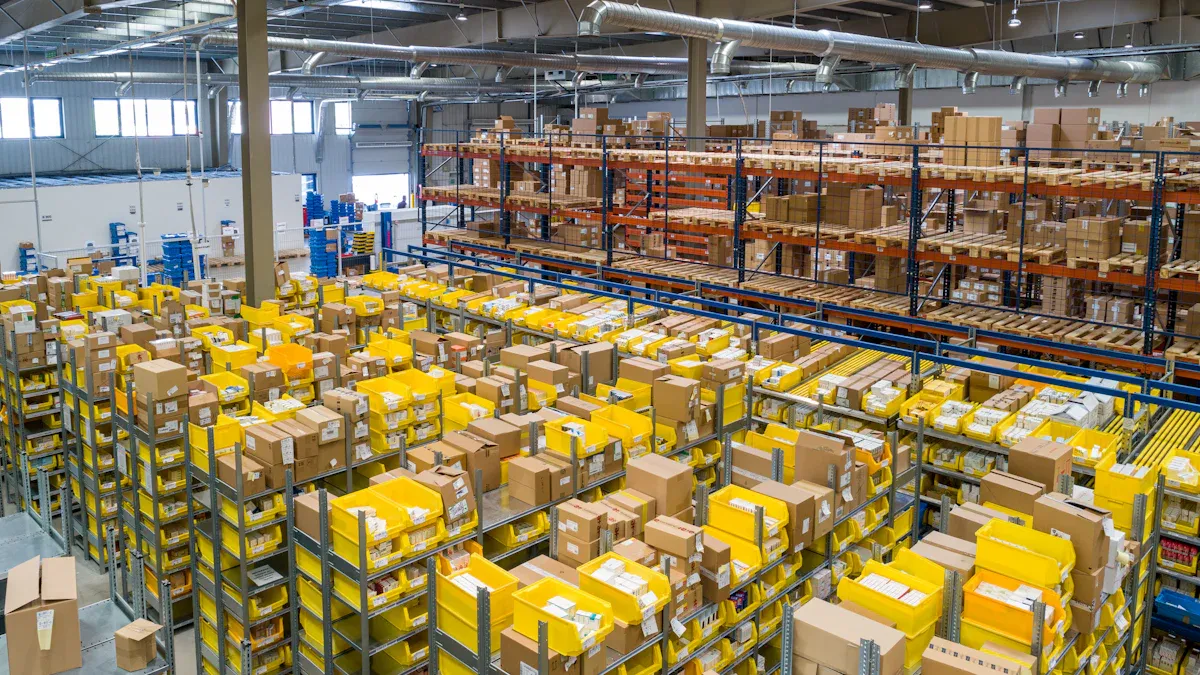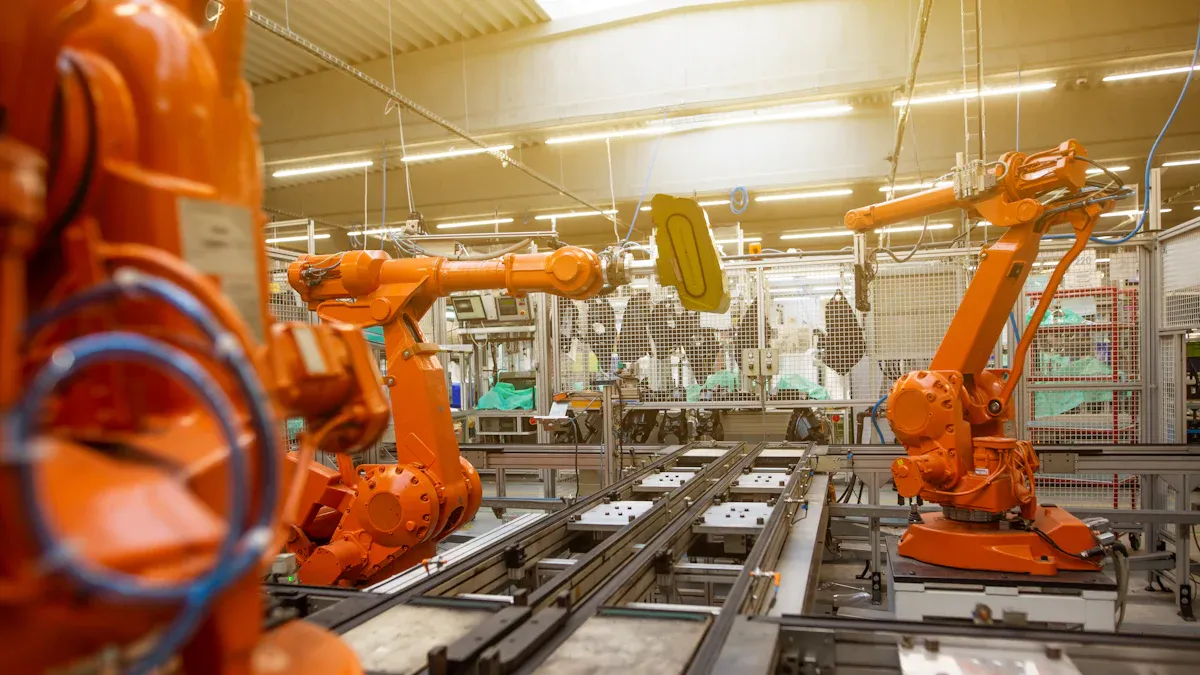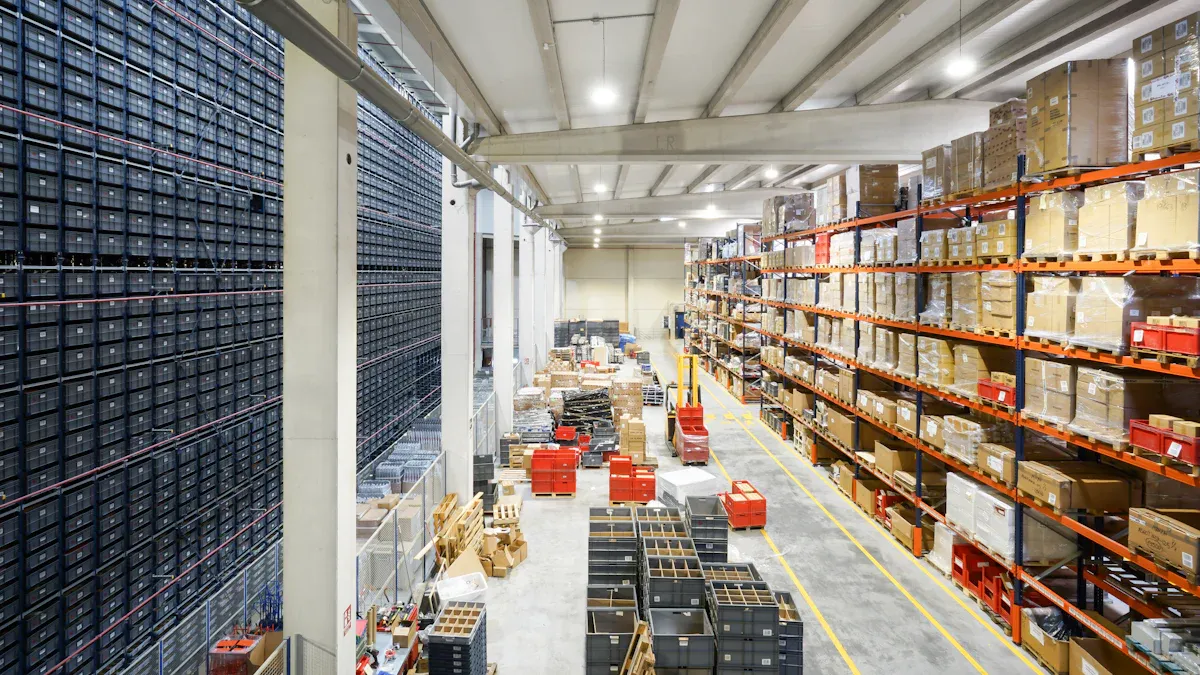Robotics and Automation in Smart Warehousing Explained

Robotics and automation in smart warehousing use machines and software. They help with jobs like moving goods, picking items, and tracking inventory. These systems make work faster and save money. They also help orders get done more quickly. Some common technologies are autonomous mobile robots (AMRs), automated guided vehicles (AGVs), and goods-to-person (GTP) systems.
The smart warehousing market will grow from $31.21 billion in 2025 to $46.42 billion by 2030.
Robotic automation can make work go two or three times faster and keep inventory accuracy at 99.9%.
Key Takeaways
Robotics and automation make warehouse jobs much faster. They can make work two or three times quicker. They also help workers make fewer mistakes. Accuracy can reach 99.9%.
Smart technologies like Autonomous Mobile Robots and Goods-to-Person systems help stop errors. They also keep inventory neat and easy to find.
Robots do the heavy lifting and boring jobs. This keeps workers safe and helps prevent injuries in warehouses.
Using robotics can help companies save money. It lowers labor costs and makes work more efficient. Robots often pay for themselves in less than two years.
To use robotics, warehouses should look at what they need. They should make a good plan and train workers. This helps everything go smoothly.
Understanding Robotics and Automation
Key Concepts
Robotics and automation in smart warehousing use machines, robots, and software to do jobs people did by hand before. These tools help warehouses work faster and with fewer mistakes. The table below lists some important words and what they mean:
Term | Definition |
|---|---|
Smart Warehousing | Integration of advanced technologies to digitize and automate warehouse processes for efficiency. |
Automation | Application of machines and software to perform tasks previously done manually in warehouses. |
Robotics | Use of robotic systems to automate storage, retrieval, and handling of goods in a warehouse. |
Autonomous Mobile Robots | Robots that move autonomously within the warehouse to transfer goods. |
Robotic systems that automatically store and retrieve products from racks. | |
Collaborative Robots (Cobots) | Robots designed to work alongside humans, performing repetitive tasks to enhance efficiency. |
Warehouses use different systems to help store and move things better. Automated Storage and Retrieval Systems (AS/RS) put and pick items from shelves. These systems use AI to find the best place for each item. This makes work faster and easier.
Robots in warehouses use sensors and cameras to move and not bump into things. They get directions from central software. Some robots learn from data and improve over time. Cobots work with people to help pick and pack items. Robots go back to charging stations when their batteries are low. They also get regular checkups to keep working well.
Importance in Warehousing
Robotics and automation change how warehouses work. They give many benefits:
They help make fewer mistakes when picking and sorting.
AI-powered robots keep track of inventory and help stop running out or having too much.
Robots do dangerous jobs, so people stay safer.
Companies save money because they need fewer workers and spend less over time.
Tip: Warehouses using robotics and automation can fill orders faster and keep better track of inventory.
These tools help warehouses meet customer needs quickly and safely. They make jobs easier for people and help companies grow.
Technologies in Smart Warehousing

Smart warehouses use new technology to work better. These tools help do jobs automatically. They also help stop mistakes and make things run smoothly.
Autonomous Mobile Robots (AMRs)
AMRs move things in the warehouse by themselves. They use sensors and cameras to look around. These robots make maps of the warehouse. They find the best way to go. AMRs can fit in small aisles and busy spots. They get jobs from main software. They change their path if needed. This helps warehouses deal with changes fast and safely.
AMRs help move items to the right place.
They use smart programs to do jobs and dodge things.
The robots scan the warehouse first to make a map.
Automated Guided Vehicles (AGVs)
AGVs carry pallets, boxes, and other things. They follow set paths made by wires, magnets, or sensors. AGVs help move raw materials and finished goods. They also move items being worked on. They cut down on hard work and keep things moving.
AGVs move goods in and out, making restocking quicker.
They work with people when picking and packing.
AGVs make things safer by moving heavy loads instead of people.
Goods-to-Person (GTP) Systems
GTP systems bring items straight to workers. This means workers walk less and find products faster. GTP systems use robots or belts to send goods to picking spots.
Metric | Traditional System | GTP System |
|---|---|---|
Time spent picking | 40% | 100% |
Productivity increase | N/A | |
Labor cost reduction | N/A | Yes |
Order accuracy improvement | N/A | Yes |
GTP systems help workers do more and make fewer mistakes. They also lower costs and help keep workers safe.
Warehouse Management Systems (WMS) and IoT
WMS software helps control warehouse jobs. It gives tasks to robots and checks inventory all the time. IoT devices link machines, sensors, and software. This lets them share data right away.
WMS and IoT help make choices fast and keep things working well.
WMS works with robots and automation to make things better. IoT gives updates so managers know what is happening.
All these tools work together in smart warehouses. They connect people, machines, and data. This makes every job faster and more correct.
Robotics and Automation Use Cases

Automated Goods Transport
Smart warehouses use automated goods transport to move products fast and safely. Companies use groups of AMRs and AGVs to carry things between storage, picking, and shipping spots. These robots help workers walk less and avoid carrying heavy things. For example, Amazon uses Kiva robots to bring shelves to packers, so workers travel less. DHL uses Locus AMRs to pick more cases each hour and make workers happier. ASRS goods-to-person robots are good for tight storage and quick restocking. Collaborative robotic arms help with careful item handling, making work easier for people.
Use Case | Description |
|---|---|
Kiva/AMR Robots | Bring shelves to packing spots, so workers walk less. |
Locus AMRs | Pick more cases each hour and make fewer mistakes. |
Collaborative Robotic Picking | Pick items like medicine without people doing it all. |
ASRS Goods-to-Person Robots | Help store things tightly and restock quickly. |
Fleets of AMRs | Let workers pick many orders at once during busy times. |
Collaborative Robotic Arms | Help with careful handling, so workers do not get tired. |
AMRs and AGVs also help in car factories and medicine companies. In these places, robots bring parts to workers or move special materials in clean rooms.
Robotic Picking and Packing
Robotic picking and packing help warehouses fill orders faster and with fewer mistakes. These systems use robotic arms, AI, and sensors to grab items from shelves and pack them for shipping. Robotic systems can pick with almost perfect accuracy, so there are fewer errors and returns. ASRS can cut picking mistakes by a lot compared to people doing it by hand. Robots can pick items much faster than people. Digital systems help workers do more and keep less extra stock. Labor costs go down when robots do the work. ASRS can help pick more items and use less space for storage.
Robotic picking systems also make work smoother. They help workers walk less, which saves time and energy. These systems work all the time, even when it is busy, so warehouses can handle more orders without waiting.
Inventory Management
Warehouses use robotics and automation to keep better track of inventory. IoT devices send data all the time, so managers know what is in stock right away. AI looks at this data to find the best amount of stock and guess what will be needed next. Robots pick and pack items, making the process more correct and quick. In AI-supported warehouses, orders are almost always right, so there are fewer returns. Automation means workers do not have to count stock by hand as much, and stock records are better.
Smart inventory management helps companies avoid running out of products or having too much. This helps customers get what they want and saves money.
Safety and Hazard Prevention
Robotics and automation make warehouses safer by doing dangerous jobs. Robots lift heavy things and walk long distances, so people do not get hurt as much. Studies show that robotic warehouses have fewer bad injuries. Automation can lower workplace injuries by a lot. Robots also keep people away from risky jobs, so they do not get too tired. Smart hazard systems warn workers about dangers, which helps stop accidents. Automated systems follow rules, so there are fewer mistakes and the warehouse is safer.
But, some studies say small injuries can go up when it is busy. This means warehouses need to teach workers how to be safe with robots and keep safety tools updated.
Order Fulfillment
Order fulfillment gets faster and more correct with robotics and automation. Pick-to-light and put-to-light show workers where to find and place items, so they learn faster and make fewer mistakes. Robotic picking uses AI and robotic arms to handle items quickly and work without stopping. Automated conveyors move goods fast, so busy warehouses can ship more.
Technology | Benefit Description |
|---|---|
Pick-to-Light (PTL) | Shows workers where to find items, so picking is faster and better. |
Put-to-Light | Tells workers where to put items, so sorting is quicker. |
Robotic Picking | Uses AI and robotic arms to handle items all the time. |
Automated Conveyor | Moves goods by itself, so workers do not have to carry things and more items can be shipped. |
Robot and human teams can get more done together. AMRs can help workers pick more items each hour. Smart computer programs and cameras help make work fast and correct. Robots work all the time, so warehouses can fill lots of orders and deliver on time.
In online shopping, AMRs help bring items to workers, so they walk less and pick faster. AGVs move big loads to shipping or restock shelves. These tools help companies keep up with fast and correct delivery for customers.
Business Benefits and Implementation
Efficiency and Cost Savings
Robotics and automation help warehouses save money and work faster. Robots can work all day and night without stopping. This means more orders get filled quickly. Companies have fewer mistakes and spend less fixing problems. Labor costs go down because robots do hard jobs. Warehouses use less space and energy, which saves even more money. Many businesses get their money back in less than two years.
Benefit | Description |
|---|---|
Robots work without breaks, moving goods quickly and reducing slowdowns. | |
Reduction in labor costs and errors | Fewer workers are needed, and robots make fewer mistakes. |
Enhanced safety | Robots handle dangerous tasks, so people stay safer. |
Scalability | Warehouses can handle more orders without hiring more people. |
Better data visibility | Managers see real-time updates and can fix problems quickly. |
Many companies see big improvements in speed and savings after using robotics and automation.
Accuracy and Productivity
Robots help pick, pack, and move items with high accuracy. They use sensors and maps to find the right path. This helps them avoid mistakes. Orders get filled faster and with fewer errors. Workers can do important jobs while robots do simple tasks. Customers get their orders on time. They are happier because there are fewer mistakes and delays.
Robots make picking and packing faster.
Automation lowers mistakes in sorting and shipping.
Real-time tracking keeps inventory correct.
Customers are happier with quick and accurate deliveries.
Implementation Steps
Warehouses can follow these steps to start using robotics and automation:
Assess: Find out which jobs take the most time or cause the most problems.
Plan: Pick the right robots and set clear goals.
Deploy: Set up the robots and teach workers how to use them.
Learn: Watch how things work and train staff to get better results.
Scale: Add more robots or new systems as the warehouse grows.
Training and good communication help workers feel okay with new technology. Starting with small test programs can make the change easier.
Warehouses that use robotics and automation work faster and make fewer mistakes. Customers are happier. These steps help companies get the most from their investment.
Robotics and automation make warehouses work in new ways. They help companies spend less money and finish orders faster. Studies show robots cut labor costs over time. Robots can work all day without stopping. Experts say there are many good things about using robots:
Work gets done faster and more items move.
There are fewer errors and jobs are safer.
Inventory is tracked better and costs go down.
Warehouses can grow fast and customers are happier.
Managers can look at what has worked for others. The table below lists key steps for planning a smart warehouse:
Step | Description |
|---|---|
Technology Selection | Pick robots that fit what the warehouse needs |
System Design | Make systems that can change as the warehouse grows |
Change Management | Teach workers and talk about any worries |
KPIs | Watch speed and accuracy to get better |
Robotics and automation help warehouses get bigger and change when needed. Managers who plan and teach workers well get the best results.
FAQ
What is the difference between AMRs and AGVs?
AMRs can move around on their own and change direction with sensors. AGVs have to follow paths made by wires or magnets. AMRs are good for places with lots of people or things moving. AGVs are better for simple jobs that happen the same way every time.
How do robots improve warehouse safety?
Robots pick up heavy things and do jobs that could be dangerous. This helps workers not get hurt and keeps them safe. Automated systems can tell people if something is not safe. When robots and people work together, everyone is safer.
Can small warehouses use automation?
Small warehouses can use automation too. They can start with easy robots or simple computer programs. Automation helps them save time and money. Using smart tools makes it easier for small warehouses to grow.
How does automation affect warehouse jobs?
Automation changes some jobs in the warehouse. Workers do not have to lift heavy things as much. They help control robots and fix problems instead. Training helps workers learn new things for their jobs.
What is a Warehouse Management System (WMS)?
A WMS is a computer program that keeps track of inventory and warehouse work. It tells robots what to do and gives updates to managers. WMS helps keep the warehouse neat and makes sure everything works well.
See Also
The Future Lies in AI-Driven Retail Experiences
Automated Vending Machines Are Shaping Fast Food's Future
Transforming Online Retail Management with AI Tools
Smart Technology in Electronics Vending Machines Revolutionizes Retail
Modern Retail Benefits from AI-Enhanced Combo Vending Machines
